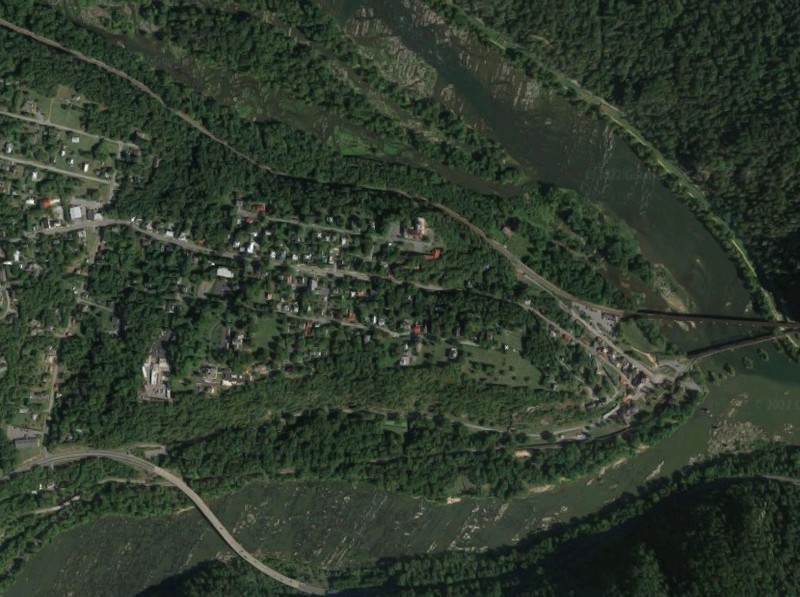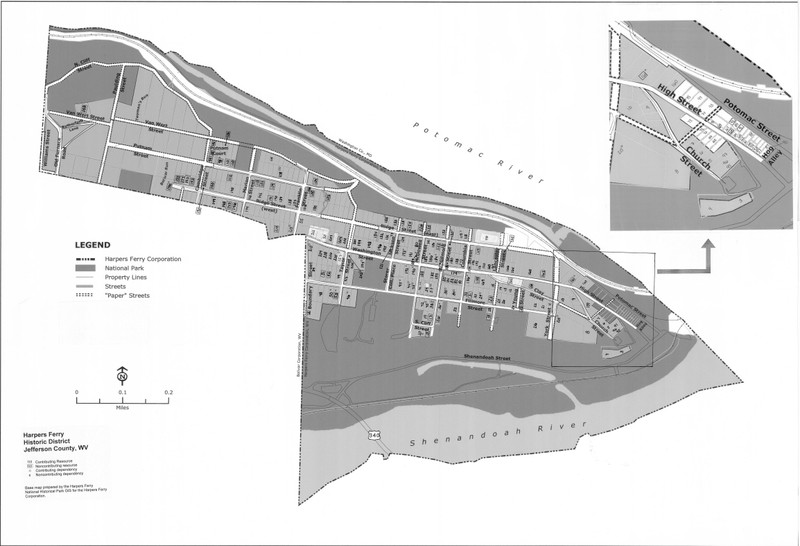This entry includes a walking tour! Take the tour.
Introduction
Text-to-speech Audio
Harpers Ferry Historic District contains the historic buildings and areas of Harpers Ferry that are not included in Harpers Ferry National Historical Park. The town of Harpers Ferry contains significant history related to eighteenth century settlement, nineteenth century industry, John Brown's 1859 raid, the Civil War, and African American education. The National Historical Park was established in 1963 and its area/structures was listed on the National Register of Historic Places in 1966. The surrounding Historic District was added to the National Register in 1979.
Images
Aerial view of Harpers Ferry Historic District and Harpers Ferry National Historical Park

Map of Harpers Ferry Historic District from 2009 Additional Documentation

Backstory and Context
Text-to-speech Audio
The land that became Harpers Ferry was originally part of the Thomas Fairfax holdings. Millwright Robert Harper purchased 125 acres of land from Fairfax on April 5, 1751. Harper established a water powered sawmill, ferry, and a stone tavern. Robert Harper died in 1782 and his holdings were inherited by his niece, Sarah Harper, and her husband John Wager, Sr. The Wagers lived in Philadelphia and controlled the development of Harpers Ferry from afar until 1836.
During the early nineteenth century, Harpers Ferry was a center for industry and transportation. In August 1785 George Washington visited Harpers Ferry and selected it as the location for a new Federal musket producing armory due to the potential for waterpower. The United States purchased 118.25 acres of land from the Wagers, with the family keeping the two Wager tracts (the Six Acre Wager Reservation and ¾-acre Ferry Lot Reservation). The U. S. began construction on the power canal, dams, and factory buildings in 1798 and arms production began in 1802. The presence of the armory spurred the exponential growth in the town and the factory produced more than 500,000 firearms for the United States by 1860.
In addition to the federal presence at Harpers Ferry, the area was a center of private industrial growth, particularly along the Shenandoah River at Virginius and Hall Islands. The potential for waterpower was being used as early as the 1820s and in the 1850s Abraham Kerr 39 industrial or related structures on Virginius Island. Hall’s Island just to the west was the site of the Lower Hall Rifle Factory in the 1820s. While new interchangeable technology was already being adapted by the U.S. government, John Harris Hall developed a system to mass produce truly interchangeable parts for a breechloading flintlock rifle. Hall was contracted by the United States to set up the machinery needed for this process on Hall Island and produce his rifles for the government.
Transportation and Industry were both prominent themes in early Harpers Ferry. The Baltimore & Ohio Railroad meets the Winchester & Potomac Railroad in Harpers Ferry, along with the Chesapeake and Ohio Canal. The canal was a way to transport goods from Cumberland, Maryland to Washington DC. With it’s ideal location for water powered factories, Harpers Ferry was home to cotton mills, paper mills, rifle works, and the Federal Armory and Arsenal. However, when you visit the park today all that remains are the ruins of the once industrial town due to the flooding that occurred.
Harpers Ferry is perhaps most famous for John Brown’s Raid in October 1859. John Brown was an avid abolitionist and became known as “Osawatomie Brown” for his actions in “Bleeding Kansas,” and became a wanted man for killing five pro-slavery individuals. In Harpers Ferry, Brown devised a plan to lead a raid on the federal armory and arsenal. Brown’s plan was to obtain weapons from the armory and free all of the slaves in the south by providing them with weapons to rebel. Brown and his 18 raiders hid out at the nearby Kennedy Farm house in Maryland. On the eve of October 16th, 1859 Brown and his raiders entered the silent town of Harpers Ferry, it was a drizzly Sunday night. Brown’s men took several local citizens as prisoners, and once the local militia began to exchange fire, Brown took coverage in the armory’s fire engine house, now referred to as John Brown’s Fort. The U.S. Marines from Washington D.C., under the command of Colonel Robert E. Lee offered Brown terms of surrender. Brown refused and after a short three-minute struggle Brown was captured and put under arrest. Brown was tried and found guilty of three crimes: murder, treason, and conspiring and inciting a slave rebellion, and was sent to the gallows on December 2, 1859. John Brown is quoted with his last words being “I John Brown, am now quite certain that the crimes of this guilty land, will never be purged away with blood.” Brown was envisioning a Civil War to occur and it did.
During the Civil War, Harpers Ferry was constantly in the path of the opposing armies. In 1861, at the very beginning of the conflict the Federal soldiers at the arsenal were forced to leave Harpers Ferry with the approach of Virginia’s state troops (once Virginia seceded and joined the Confederate States). The Federal force set fire to several of the buildings before the Confederates occupied the town. The other large wartime event was the Battle of Harpers Ferry in September 1862 when Confederate General Thomas “Stonewall” Jackson approached the town during the Antietam Campaign and forced the surrender of the entire Union force there. Harpers Ferry was occupied by both forces several times over the course of the Civil War and much of the industrial sector was destroyed during the conflict. The damage from the war plus a series of major floods after 1870 largely caused Harpers Ferry to go into decline in the late nineteenth century.
Harpers Ferry also holds a history of African Americans in West Virginia. After the American Civil War a school to educate newly freed African Americans was formed by missionaries. The school later turned into Storer College. In 1906, on the campus of Storer College, the second meeting of the Niagara Movement took place, and was led by W.E.B DuBois. The Niagara Movement was the forerunner of the NAACP. Storer College ended in 1954, when the Supreme Court decision Brown v. Board of Education was passed making segregated schools illegal. Today, Storer College is a training center for the National Park Service.
In 1944 the U. S. Congress recognized the historical significance of Harpers Ferry with legislation that allowed up to 1,500 acres to be designated as a national monument. It was officially declared a National Historical Park in 1963 and was listed on the National Register of Historic Places in October 1966.
Sources
"National Register of Historical Places Inventory--Nomination Form: Harpers Ferry National Historical Park." Accessed July 29, 2021. http://www.wvculture.org/shpo/nr/pdf/jefferson/66000041.pdf.
"Share Harpers Ferry." E-WV. Accessed October 03, 2016. http://www.wvencyclopedia.org/articles/263.
"Share John Brown." E-WV. Accessed October 03, 2016. http://www.wvencyclopedia.org/articles/668.
Google Maps. Accessed May 22, 2022.
“Harpers Ferry Historic District (additional information).” National Register of Historic Places Continuation Sheet. Accessed May 6, 2022. https://wvculture.org/wp-content/uploads/2021/03/Harpers-ferry-historic-district-additional-info.pdf
